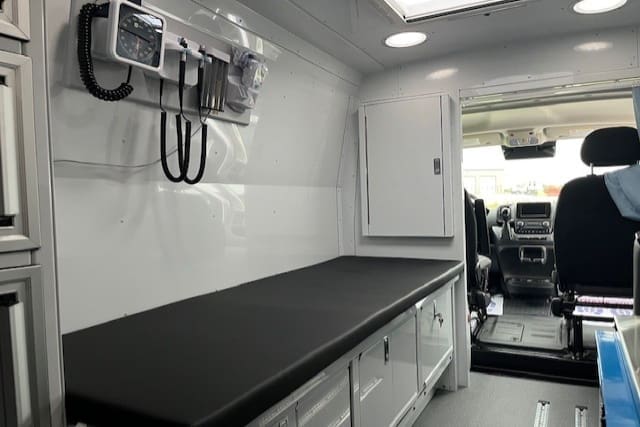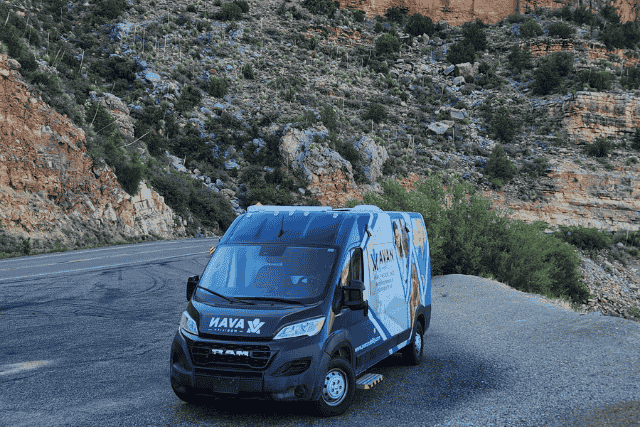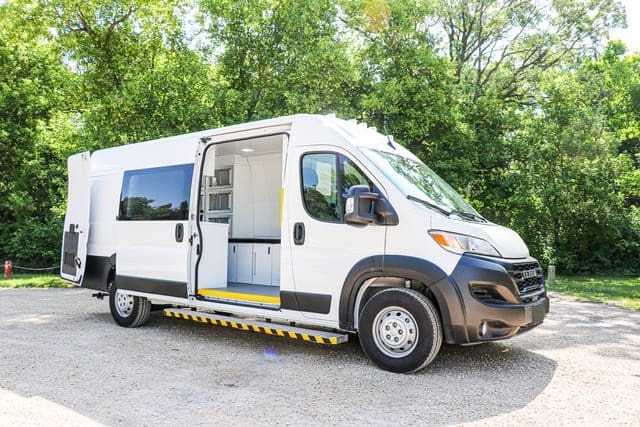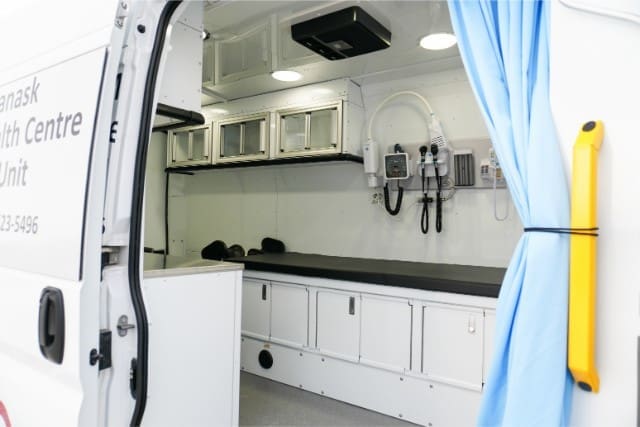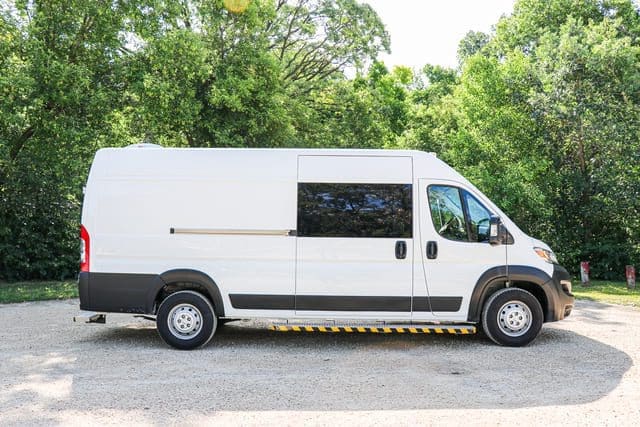Did you know that one in three counties in New Mexico has no hospital offering maternity care? If your program or organization works with expectant mothers in these areas, you already feel the weight of this gap. You see women driving hours to appointments, skipping prenatal care, or giving birth far from home. That’s scary, and it leaves families feeling isolated and at risk.
Fewer services mean more stress, more danger, and less support. But imagine a world where every mother, no matter her ZIP code, could access care without fear of distance. That’s the desired future we’re talking about.
At AVAN Mobility, we care about helping you reach that future. For over 10 years, we’ve partnered with health networks, nonprofits, and local governments to create mobile healthcare units. Teams like CalOptima and the Community Clinic of Southwest Missouri have trusted us to help them break down barriers to care. We’re Ford QVM and Stellantis QPro certified, which means you can trust the safety and quality of our vehicles. And while we believe in our work, we also know we’re not the only option out there, which is why we focus on giving you the facts first.
In this article, you’ll learn:
- The state of maternity care in New Mexico
- The gaps these deserts create
- How mobile OB-GYN solutions can help
What’s the state of maternity care in New Mexico?
Maternity care in New Mexico is facing big challenges. Many families live in counties with no hospital or birth center offering maternity care. For expecting mothers, this means long drives, missed appointments, and extra stress during an already vulnerable time. To really understand the problem, let’s break it down into a few key areas.
1. Limited access to hospitals and clinics
In New Mexico, many rural counties don’t have a single hospital with labor and delivery services. According to the March of Dimes, 34% of counties in the state are considered maternity care deserts. That means thousands of women live far away from essential care.
For moms-to-be, this gap creates real risks:
- Long travel times: Some women have to drive hours for prenatal checkups or delivery.
- Fewer safety nets: Complications can’t always wait for the long trip to the hospital.
- More missed care: Busy schedules, low income, and transportation challenges make it easy to skip appointments.
This lack of local care leaves many families feeling forgotten. It can increase stress, harm health outcomes, and make pregnancy feel scary instead of joyful. When maternity care deserts stretch across so much of New Mexico, the impact reaches entire communities, not just individual mothers.
2. Travel puts Moms at risk
Even when hospitals exist in New Mexico, the long distances many families travel for maternity care create serious risks. If you live in a rural county, driving over an hour for a prenatal check-up is common. For some moms, it can mean missing appointments altogether because the trip is too costly or time-consuming.
Research shows that travel isn’t just inconvenient, it’s dangerous. When moms don’t get regular prenatal care, complications often go unnoticed until they become emergencies. According to state health reports, New Mexico has higher rates of pregnancy-related deaths and severe complications compared to the U.S. average.
Here’s how distance impacts care:
- Missed prenatal visits: Moms skip appointments when it means losing a day’s work or finding childcare.
- Delayed emergency response: Labor can move quickly, and long travel times to hospitals increase the risk for both mom and baby.
- Stress and fatigue: Driving hours while pregnant adds physical strain that can make pregnancies harder to manage.
The story here isn’t just about hospitals missing in rural counties. It’s about the very real danger of distance and how it directly shapes outcomes for moms and babies across the state.
3. How severe are maternal health outcomes in New Mexico?
In New Mexico, the risks during and after pregnancy are higher than the U.S. average. The state’s maternal mortality rate was 31.2 deaths per 100,000 live births in 2020, nearly double the national average of 17.3.
That number only scratches the surface. Many of those deaths are driven by mental health struggles, substance use, and even discrimination. More than 48% of pregnancy-related deaths were linked to discrimination, and over half were associated with substance use.
Here’s what that means for moms and babies:
- More tragic outcomes: Moms are more likely to face life-threatening complications during or after birth.
- Postpartum risks linger: Nearly half of deaths happen well after delivery—when moms might think the danger is over.
- Shockingly high disparity: Indigenous women face maternal mortality rates 1.5 times higher than non-Hispanic white women.
These are more than numbers. They’re stories of families and communities hurting without enough support. That’s why finding ways to bring sensitive, essential care closer to those who need it matters more than ever.
4. Women in New Mexico start prenatal care later than in most states
Many expecting moms in New Mexico begin prenatal care much later than recommended. In fact, for one in three women statewide, and about one in two Indigenous women, care in the first trimester doesn’t happen at all. That’s a problem, because early visits help catch complications before they become emergencies.
Since the COVID years, things have only gotten more difficult. Several hospitals across the state closed their maternity wards, including Rehoboth McKinley in Gallup and Alta Vista in Las Vegas, making regular checkups even more difficult.
When moms delay care or skip early checkups, here’s what often happens:
- Hidden risks grow: Conditions like high blood pressure or diabetes may go undetected.
- Higher chances of preterm birth or complications: Without early monitoring, problems can progress.
- Added stress for families: Long travel, missed work, or juggling childcare can delay care even more.
Late or missed prenatal care can ripple out to affect mom and baby’s health, and your program’s success in supporting them. Access isn’t just about hospitals on the map; it’s about timing, early connection, and trust.
5. Postpartum care in New Mexico is a challenge
Getting care after birth matters a lot. Unfortunately, New Mexico doesn’t do as well as other states. In 2020, just 86.2% of new mothers in New Mexico got a scheduled postpartum checkup, well below the U.S. average of 88.1%. That gap means about 1 in 7 moms in New Mexico, and roughly 1 in 8 nationwide, may have gone without essential postpartum care when they needed it most.
Skipping that visit is more than missing a doctor’s appointment. It’s missing a chance to:
- Spot mental health concerns, like postpartum depression
- Manage complications, such as infection or bleeding
- Access support for breastfeeding, physical recovery, and emotional health
When postpartum care slips through the cracks, mothers can face serious risks. Nearly half of pregnancy-related deaths in New Mexico happen after 42 days postpartum, a time when many women stop checking in with their healthcare team.
How does mobile maternity care help New Mexico families?
If you work in maternity care, you’re familiar with some of these gaps we talked about in New Mexico.
But here’s the good news: Mobile maternity care can meet moms where they are. Instead of waiting for families to find help, care comes right to their doorsteps.
Let’s walk through what that looks like.
Reaching families in remote areas
Imagine a young mom in rural Catron County. The closest hospital with maternity services is more than 100 miles away. For her, a routine check-up feels impossible. But with a mobile OB-GYN clinic, your team could drive into her community once a week. She wouldn’t need to worry about travel, gas money, or who would watch her kids. Care shows up for her.
Supporting moms during pregnancy
Prenatal visits catch problems early. But in many parts of New Mexico, these visits happen less often because of distance. Picture a mom in Rio Arriba County who works long hours and can’t take full days off. A mobile clinic parked outside her workplace or community center means she can check her blood pressure, talk to a nurse, and hear her baby’s heartbeat during her lunch break. That’s powerful.
Helping with postpartum care
Postpartum care is one of the biggest gaps. Let’s say a mom in McKinley County gives birth but doesn’t make it back for her six-week visit. She may miss warning signs of infection or depression. But a mobile unit could meet her at a local church parking lot or even outside her home. That one visit could save her life and give her peace of mind.
Making care more private and comfortable
Stigma is real in small towns. Some moms don’t want neighbors knowing they’re seeing a counselor or struggling after birth. A mobile OB-GYN clinic offers quiet privacy. For example, instead of walking into a busy office in a town where everyone knows each other, she can meet one-on-one with your team inside the clinic. It feels safe, personal, and respectful.
Bringing culturally relevant support
New Mexico is home to diverse communities, including Native American and Hispanic families. Mobile maternity care allows your team to bring culturally sensitive support directly into these communities. Imagine a clinic visiting a Pueblo community where providers speak the language and understand traditions. Moms feel heard, respected, and more likely to stay engaged with care.
Why is mobile OB-GYN such a big deal?
Mobile maternity care isn’t a replacement for hospitals, but it fills the gaps where access falls short.
With mobile OB-GYN units, your program could:
- Lower barriers: Meet moms closer to home.
- Catch issues sooner: Provide prenatal and postpartum checks on time.
- Build trust: Offer care in a private and respectful way.
- Save lives: Address complications before they become emergencies.
Mobile OB-GYN units bring dignity and hope. They make care real for moms who might otherwise go without. In a state where maternity care deserts are the norm, these clinics help close the gap one visit, one family, and one community at a time.
Ready to bring maternity care to New Mexico families with a mobile clinic?

You came to this article because you see the challenge: New Mexico’s moms struggle to get maternity care. Distance, cost, and lack of providers are leaving expecting mothers without the care they deserve.
What you learned today:
- The current state of maternity care in New Mexico is alarming, with many counties lacking OB-GYNs and hospitals.
- Mobile maternity care can help your organization close these gaps with on-the-ground solutions like prenatal visits, postpartum support, and culturally sensitive care.
At AVAN Mobility, we’ve spent over a decade building vehicles that help organizations like yours save lives. Our work goes beyond the vans themselves. We partner with you to design mobile medical units that reflect the needs of your patients and communities.
From listening to your challenges to tailoring solutions that fit your program, we walk beside you the whole way. We believe healthcare should meet people where they are, and we’re proud to help make that happen. If you’d like to talk through how mobile maternity care could work for your program, click the button below to connect with one of our mobility experts.
If you’re not ready to talk to a mobility expert yet, we’ve got a few resources you’ll find helpful:
- What is a mobile maternity clinic? Learn exactly how a mobile maternity unit functions and why it matters.
- Mobile OB-GYN vs. traditional pregnancy centers: See the benefits and differences so you can decide what fits your program best.
- Top 10 tips on fundraising for a Mobile Clinic Van: Get practical ideas to secure funding for your own mobile maternity care solution.
